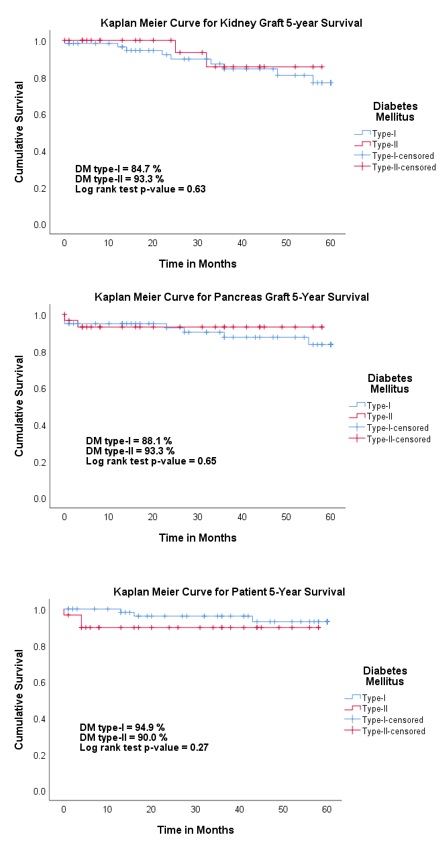Outcomes of Simultaneous Kidney-Pancreas Transplantation in Patients with Type-I and Type-II Diabetes Mellitus
1Advanced Surgery, John C. McDonald Regional Transplant Center - Willis Knighton Health System, Shreveport, LA, 2Transplant Nephrology, John C. McDonald Regional Transplant Center - Willis Knighton Health System, Shreveport, LA
Meeting: 2021 American Transplant Congress
Abstract number: 1240
Keywords: Graft survival, Kidney/pancreas transplantation, Obesity, Outcome
Topic: Clinical Science » Pancreas » Pancreas and Islet: All Topics
Session Information
Session Name: Pancreas and Islet: All Topics
Session Type: Poster Abstract
Session Date & Time: None. Available on demand.
Location: Virtual
*Purpose: UNOS approved simultaneous kidney-pancreas transplantation (SKPT) for type-II diabetes mellitus (DM) in Oct 2014. There is limited data comparing outcomes of SKPT in type-I versus type-II DM. The aim of this study was to measure the change in volume of SKPT since UNOS approved it for type-II DM patients and compare death-censored 5-year kidney and pancreas graft and patient survival between type-I and type-II DM patients undergoing SKPT.
*Methods: We conducted a single-center retrospective chart-review study on SKPT patients from Jan 2010 to Nov 2020 and collected data on patient demographics, BMI, c-peptide, HbA1c, and eGFR. Student’s t-test for continuous variables, Chi-square test for categorical variables, and Log rank test for survival analysis were done using SPSS.
*Results: Among 89 SKPT, 18 (all type-I DM) and 71 (41 type-I and 30 type-II DM) were done pre- and post-approval of SPKT for type-II DM respectively. This translated to an increase in SKPT from 3.6/year to 11.8/year (228% increase). There were no statistically significant differences in c-peptide and HbA1c levels pre- and 1-year post-SKPT. Patients with type-II DM were of older age and had higher BMI and eGFR 1-year post-SKPT. There were no statistically significant differences in death-censored kidney and pancreas graft and patient survival at 5-year post-SKPT.
| DM type-I (n=59) | DM type-II (n=30) | P-Value | |
| Age (Y), mean ± SD | 40.2 ± 9.5 | 47.4 ± 8.8 | <0.01 |
| Male, % (n) | 62.1 (36) | 61.3 (19) | 0.94 |
| BMI (kg/m2) Pre-SKPT, mean ± SD | 25.9 ± 4.2 | 27.0 ± 2.8 | 0.15 |
| BMI (kg/m2) 1-Year Post-SKPT, mean ± SD | 26.7 ± 4.6 | 32.0 ± 3.7 | <0.01 |
| eGFR (ml/min/1.73m2) Pre-SKPT, mean ± SD | 13.0 ± 8.0 | 13.6 ± 9.3 | 0.83 |
| eGFR (ml/min/1.73m2) 1-Year Post-SKPT, mean ± SD | 62.0 ± 18.6 | 76.7 ± 22.6 | 0.04 |
| Death-Censored 5-Year Kidney Graft/Pancreas Graft/Patient Survival, % | 84.7/88.1/94.9 | 93.3/93.3/90.0 | 0.63/0.65/0.27 |
*Conclusions: Approval of SKPT for type-II DM by UNOS led to an increase in SKPT with no differences in graft or patient survival between patients with type-I and type-II DM.
To cite this abstract in AMA style:
Shokouh-Amiri H, Naseer MS, Palermini A, Aultman D, McMillan R, Tandukar S, Singh N, Zibari G. Outcomes of Simultaneous Kidney-Pancreas Transplantation in Patients with Type-I and Type-II Diabetes Mellitus [abstract]. Am J Transplant. 2021; 21 (suppl 3). https://atcmeetingabstracts.com/abstract/outcomes-of-simultaneous-kidney-pancreas-transplantation-in-patients-with-type-i-and-type-ii-diabetes-mellitus/. Accessed December 18, 2025.« Back to 2021 American Transplant Congress

